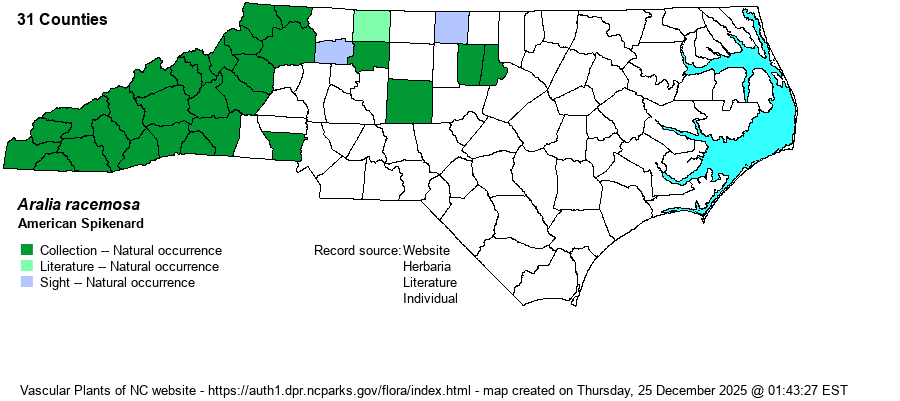| Author | L. | |
| Distribution | Throughout the Mountains; scattered in the Piedmont east to Caswell, Durham, and Randolph counties.
This is a widespread mostly Northern species, ranging from Canada south to northern GA and AR.
| |
| Abundance | Generally common in the Mountains, uncommon in the Piedmont foothills, but rare and local in the northern Piedmont. | |
| Habitat | This is a characteristic species of cove forests and other rich hardwood forests in the Mountains. In the Piedmont it is found mainly in Basic Mesic Forests; thus it strongly favors circumneutral soil in NC. | |
| Phenology | Blooms from June to August, and fruits shortly after flowering. | |
| Identification | This is a very robust herb, almost shrub-like, growing to 4-6 feet tall with long and spreading leaves. Unlike with A. nudicaulis, in A. racemosa the scattered leaves come off a single stem with the inflorescence. The leaves emerge alternately, but each is "huge" (up to 2-2.5 feet long), being dissected at least twice into pinnate sections of "leaflets", typically 6-21, and each ultimate segment being heart-shaped and 4-6 inches long. You may need to look at photos to understand what a single leaf looks like! The inflorescence is a large panicle, often 6-8 inches long and 2-3 inches wide, of small umbels of white flowers. More noticeable are the numerous dark purple berries on this panicle by late summer. Though it would seem to be a quite easily identified species, at a distance it looks like some other robust species, even some shrubs; you might note that the leaves/leaflets tend to look layered and are arranged in a horizontal plane. | |
| Taxonomic Comments | None
| |
| Other Common Name(s) | Small Spikenard; a number of other seldom used names | |
| State Rank | S4 | |
| Global Rank | G4G5 | |
| State Status | | |
| US Status | | |
| USACE-agcp | FACU link |
| USACE-emp | FACU link |

